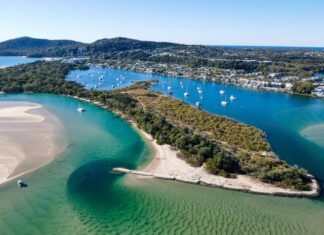While watching last weeks’ display of just how much progress has been achieved in the important field of Aerial Fire Fighting, you should have been doing so with a good feeling. The reason is two- fold. One is the progress that those involved, displayed in all aspects of their work: the other is that the three major companies involved, Fireball International (co- founder and C.E.O. Christopher Tylor), Helitak (CEO and Chief Engineer Jason Schellaars ) and McDermott Aviation ( Owner and Chief Piolet John McDermott) are all Sunshine Coast Based. All three have now achieved success and respect on the International market of engineering and fire- fighting techniques. One can’t help but feel a sense of pride in their success.
Add to this Helitak, based at Noosaville and McDermott Aviation, based in Cooroy are both in our Noosa Shire. Some time ago Noosa Today spoke with the team at Helitak and now we talk with McDermott Aviation. McDermott Aviation, under owner, director and chief piolet John McDermott, was established in 1982: beginning operations as an Aerial Application Specialist Company. Now it is Australia’s, largest privately owned helicopter company.
Despite this they are still operating out of their own original premises at Cooroy. ‘’We have evolved,’’ said John, “ from providing purely Aerial Application Operations to operating Australia’s largest fleet of privately owned helicopters. Currently, we are the industries leaders in Lifting/Ariel Crane Operations, Mosquito and Fire Ant control applications, Search and Rescue Operations, VIP charters and freight. And of course, Aerial Fire Fighting : currently holding a large number of NACF Ariel Fire Fighting contracts in Australia. We pride ourselves on our level of fire- fighting ability and customer service. As such we are also contracted to fight fires in Indonesia, Greece and New Caledonia
At present they employ over a 160 staff world- wide,(with a 100 staff on the Sunshine Coast) while owning and operating a fleet of 30 plus helicopters. ‘’We offer a large and unique variety of helicopters to suite any situation that might arise. This includes the world’s largest fleet of the most powerful single engine, twin bladed helicopter ever produced-the “Big Lifter” Bell 214B.” As Chief Piolet, John notes that this helicopter is the backbone of the McDermott Aviation International Fire Fighting Fleet, with contracts throughout Australia, New Caledonia, Papua New Guinea, the USA and Europe. “We respond to wild fires, floods and other natural disasters and emergencies- including ship salvage.” The fact that this company has achieved success and above all respect overseas, speaks for itself.
Regarding maintenance, McDermott Aviation has its own fleet of engineers and is also the largest employer of aviation apprentices. “Add to this we also have an engineering cadet program.” This staff structure and training programs, will ensure that its fleet is always ready to respond in any emergency situation. This of course would be of the utmost importance.
“However, with all the new technology at hand there are still matters that we need to address,” said John, “We need more young aircraft engineers coming through. The average age of our present group is 56 yrs. The vital role of our fire crews on the ground is of the utmost importance; trained to the level of having us airborne in 6 minutes. Our early intervention in small fires, often means the public are not aware of the great effort by the fire fighting agencies, as the success of extinguishing small fires does not attract the same level of media attention as wild fire: but it is our goal to reduce these fires.”
It should be obvious that more attention to this matter would make the general public more aware of just how dangerous these small fires can become. To educate the people to the dangers of the Australian bush fire, is of the utmost importance. When it comes to educating people, it is sad to note that, that little black box that all aircraft crash investigators seek after a major air disaster, was an Australian invention, that was ignored: it had to be taken overseas to gain attention. It is good to note that the Wednesday demonstration was attended by an estimated group of 120.
Because John’s love of flying had become very obvious, I enquired as to where it all started. “I had been employed as an aircraft engineer and took up flying as a hobby during the apprenticeship years. Then in 1977 after I had finished my training and married a lovely young lady named Linda, we went back packing through Europe. It was during this time that while travelling up the Moselle River in Germany I watched fascinated as a helicopter sprayed grape vines. That was enough: I decided then and there that flying helicopters was what I wanted to do.” And he has not looked back.
“I now have all up, a total of 45 years flying, with 40 years of commercial line.” Away from flying his hobbies are, first of all his family of wife Linda and four children,( two boys and two girls), and surfing: this includes some 14 years as a lifesaver in the Noosa club. It was during his surfing years that he became the proud sponsor of the Shirley Strachan Memorial Swim for Noosa lifesavers. This is in memory of one of Johns best mates, and now following the passing of one of the head organisers of the swim, Bruce Warren of the Noosa Club, it is now named the Bruce Warren Shirley Strachan Memorial Swim.
On looking through his years, we can proudly say that John McDermott has a list of achievements that are indeed outstanding. Helicopter piolet, engineer , designer, family man and lifesaver, not just on the beach, but also from the air: proud to say he is-One of our People.







